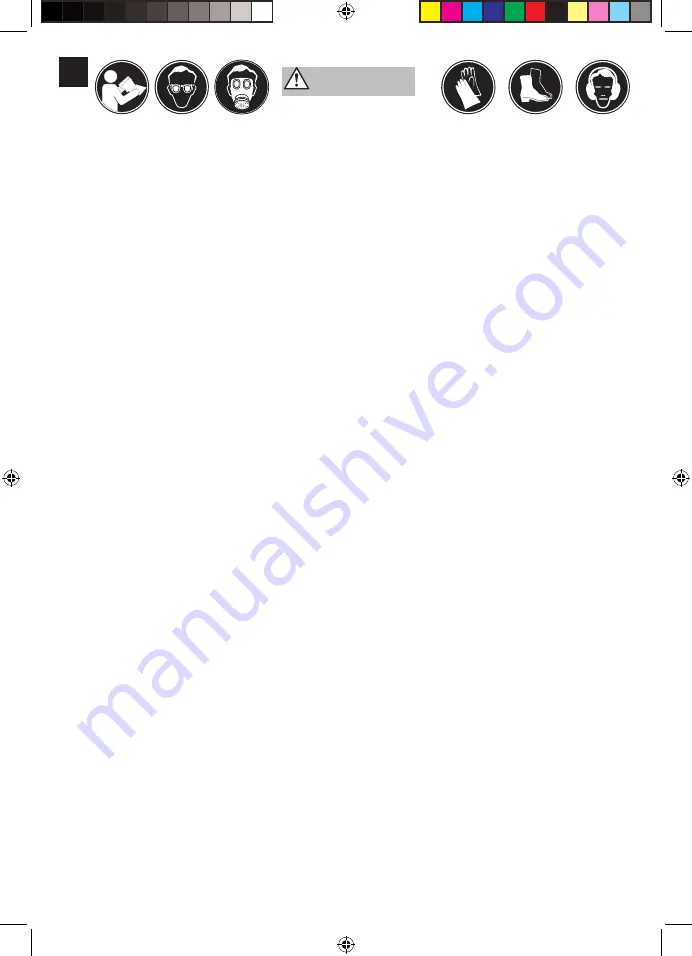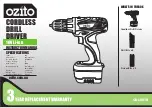
IMPORTANT SAFETY INFORMATION ENCLOSED. READ THIS MANUAL BEFORE OPERATING MACHINE.
IT IS THE RESPONSIBILITY OF THE EMPLOYER TO PLACE THE INFORMATION IN THIS MANUAL INTO THE HANDS OF THE OPERATOR.
FAILURE TO OBSERVE THE FOLLOWING WARNINGS COULD RESULT IN INJURY.
EN
WARNING
GETTING STARTED WITH THE MACHINE
• THE DRILLS ARE ONLY INTENDED FOR DRILLING METAL OR ALLOYS, WOOD,
CERAMICS AND PLASTICS. FACOM WILL NOT BE LIABLE IF THE MACHINE IS
USED FOR ANY OTHER PURPOSE.
Residual Risks
The following risks are inherent to the use of drills :
- injuries caused by touching the rotating parts or hot parts of the tool.
In spite of the application of the relevant safety regulations and the imple-
mentation of safety devices, certain residual risks cannot be avoided.
These are :
- Impairment of hearing.
- Risk of squeezing fingers when changing accessories.
- Risk of personal injury due to flying particles.
- Risk of personal injury due to prolonged use.
THIS MACHINE HAS NOT BEEN DESIGNED TO BE USED IN AN EXPLOSIVE
ATMOSPHERE.
These drills are professional power tools.
DO NOT let children come into contact with the tool. Supervision is required
when inexperienced operators use this tool.
- Young children and the infirm. This appliance is not intended for use by
young children or infirm persons without supervision.
- This product is not intended for use by persons (including children) suffering
from diminished physical, sensory or mental abilities; lack of experience,
knowledge or skills unless they are supervised by person responsible for their
safety. Children should never be left alone whith this product.
This machine and its accessories must be used in compliance with these
instructions. Using it for any other purpose may cause a risk of danger for
people and the environment.
• Always operate, inspect and maintain this machine in accordance with all
regulations (local, state, federal and country), that may apply to hand held/
hand operated pneumatic machine.
• For safety, top performance, and maximum durability of parts, operate this
machine at 90 psig (6.2 bar/620 kPa) maximum air pressure at the inlet with
3/8” (10 mm) inside diameter air supply hose.
• Exceeding the maximum pressure of 6.2 bar will lead to the risk of danger
such as excessive speed, breaking parts, higher torque or force that may
destroy the machine and its accessories or the part being worked on.
• Be sure all hoses and fittings are the correct size and are tightly secured.
• Always use clean dry and lubricated air at 90 psig maximum air pressure.
Dust, corrosive fumes and/or excessive moisture can ruin the motor of an air
machine.
• Do not lubricate machine with flammable or volatile liquids such as
kerosene, diesel or petrol.
• Do not remove any labels. Replace any damaged label.
• The use of a hose whip is recommended.
A coupler connected directly to the air inlet increases tool bulk and decreases
tool maneuverability.
• Don’t abuse hoses or connectors.
• The pneumatic machine must be fitted and connected to the compressed air
network via quick disconnects to facilitate shutdown in the event of danger.
• When the life of the tool has expired, it is recommended that the
machine be disassembled, degreased and parts be separated by material
so that they can be recycled.
• For multiple hazards, read and understand the safety instructions
before installing, operating, repairing, maintaining, changing accessories
on, or working near the drill or tapper. Failure to do so can result in
serious bodily injury.
• Only qualified and trained operators should install, adjust or use the
drill or tapper.
• Do not modify this drill or tapper. Modifications can reduce the effecti-
veness of safety measures and increase the risks to the operator.
• Do not discard the safety instructions; give them to the operator.
• Do not use the drill or tapper if it has been damaged.
• Be aware that the failure of the workpiece, or accessories, or even of
the inserted tool itself can generate high-velocity projectiles.
• Ensure that the workpiece is securely fixed.
• Operators and maintenance personnel shall be physically able to handle
the bulk, weight and power of the tool.
• Keep hands away from the rotating chuck and drill bit.
• Release the start-and-stop device in the case of an interruption of the
energy supply.
• Avoid direct contact with the inserted tool during and after use, as it can
be hot or sharp.
• Slips, trips and falls are major causes of workplace injury. Be aware of
slippery surfaces caused by the useof the tool and also of trip hazards
caused by the air line or hydraulic hose.
• Proceed with care in unfamiliar surroundings. There can be hidden
hazards, such as electricity or other utility lines.
• Ensure that there are no electrical cables, gas pipes, etc., that can cause
a hazard if damaged by use of the tool.
• Operate and maintain the drill or tapper as recommended in these
instructions, to minimize dust and fume emissions.
• Direct the exhaust so as to minimize disturbance of dust in a dust-filled
environment.
• Where dust or fumes are created, the priority shall be to control them
at the point of emission.
• Select, maintain and replace the consumable/inserted tool as recom-
mended in the instructions handbook to prevent an unnecessary increase
in dust or fumes.
• Exposure to high noise levels can cause permanent, disabling hearing
loss and other problems, such as tinnitus (ringing, buzzing, whistling or
humming in the ears). Therefore a risk assessment and implementation
of appropriate controls for these hazards are essential.
• Appropriate controls to reduce the risk may include actions such as
damping materials to prevent workpieces from «ringing».
• Operate and maintain the drill or tapper as recommended in the ins-
tructions handbook, to prevent an unnecessary increase in the noise level.
• Select, maintain and replace the consumable/inserted tool as
recommended in the instructions handbook, to prevent an unnecessary
increase in noise.
NU-VD100QR_0416 ok.indd 6
29/06/2016 11:50:33
Содержание V.D100QR
Страница 30: ...EL FACOM j 90 psig 6 2 bar 620 kPa m 3 8 10 m 6 2 bars 90 psig NU VD100QR_0416 ok indd 30 29 06 2016 11 50 57...
Страница 48: ...BG FACOM 6 2 bar 620 kPa 10 mm 6 2 bar 6 2 bar NU VD100QR_0416 ok indd 48 29 06 2016 11 52 09...
Страница 49: ...FACOM FACOM FACOM FACOM FACOM 1 2 1 3 NU VD100QR_0416 ok indd 49 29 06 2016 11 52 10...
Страница 54: ...RU FACOM 6 2 620 10 6 2 6 2 NU VD100QR_0416 ok indd 54 29 06 2016 11 52 17...
Страница 55: ...FACOM FACOM FACOM FACOM FACOM 1 2 1c 3 NU VD100QR_0416 ok indd 55 29 06 2016 11 52 18...
Страница 61: ...NOTA NU VD100QR_0416 ok indd 61 29 06 2016 11 52 28...







































